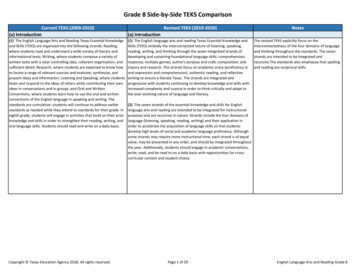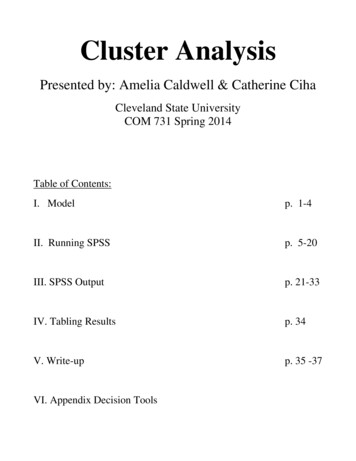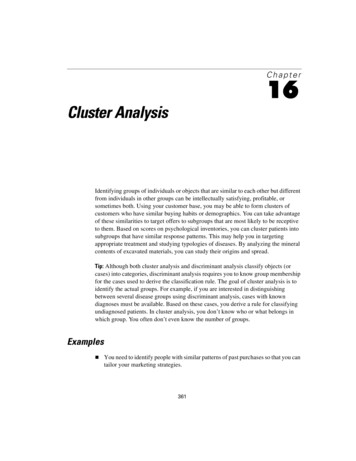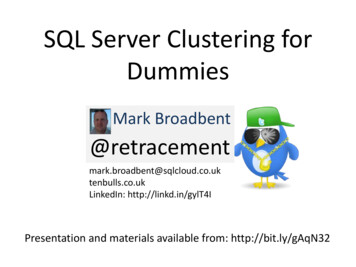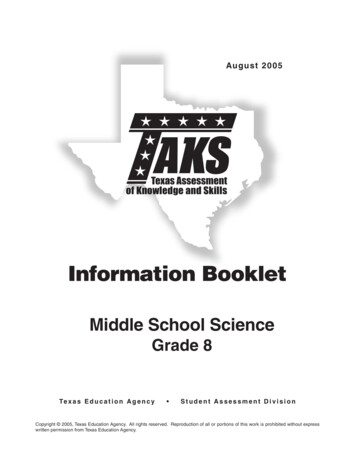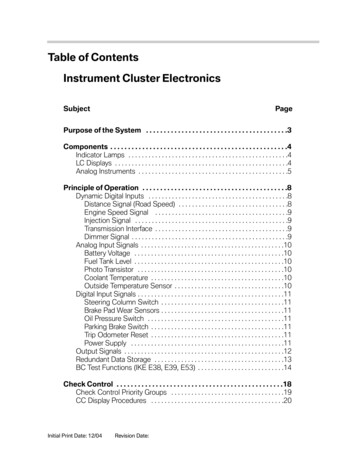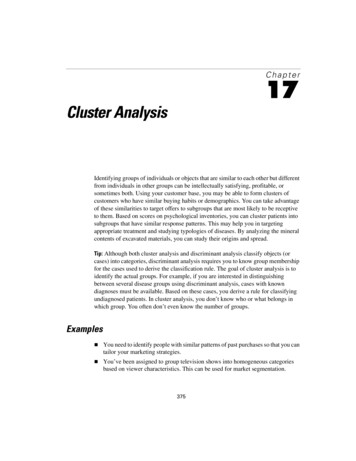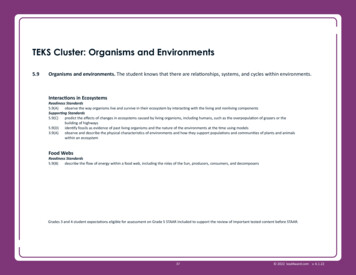
Transcription
TEKS Cluster: Organisms and Environments5.9Organisms and environments. The student knows that there are relationships, systems, and cycles within environments.Interactions in EcosystemsReadiness Standards5.9(A)observe the way organisms live and survive in their ecosystem by interacting with the living and nonliving componentsSupporting Standards5.9(C)predict the effects of changes in ecosystems caused by living organisms, including humans, such as the overpopulation of grazers or thebuilding of highways5.9(D)identify fossils as evidence of past living organisms and the nature of the environments at the time using models3.9(A)observe and describe the physical characteristics of environments and how they support populations and communities of plants and animalswithin an ecosystemFood WebsReadiness Standards5.9(B)describe the flow of energy within a food web, including the roles of the Sun, producers, consumers, and decomposersGrades 3 and 4 student expectations eligible for assessment on Grade 5 STAAR included to support the review of important tested content before STAAR.37 2022 lead4ward.com v. 6.1.22
5.9(A) ReadinessSubcluster: Interactions in EcosystemsTEKS ScaffoldTEKS6.12(E)5.9(A)Content BuilderStudent Expectationdescribe biotic and abiotic parts of an ecosystem in which organismsinteract (S)5.9 Organisms and environments. The student knows that thereare relationships, systems, and cycles within environments. The student is expected to:(A) observe the way organisms live and survive in theirecosystem by interacting with the living and nonlivingcomponents4.9(A)investigate that most producers need sunlight, water, and carbondioxide to make their own food, while consumers are dependent onother organisms for food (S)3.9(A)observe and describe the physical characteristics of environmentsand how they support populations and communities of plants andanimals within an ecosystem (R)Observe the ways organisms live and survive in their ecosystem by: Interacting with living components Interacting with nonliving componentsMajor concepts in this standard include: How an organism survives in its ecosystem How organisms interact with other living components (plants, animals) within an ecosystem How organisms interact with nonliving components of an ecosystemInstructional ImplicationsIn previous grades, students learned about plants and animals and described their physical characteristics. With 5.9(A), students learn how living organisms (plants and animals) survive and interact with oneanother. Additionally, they learn about how nonliving components impact living organisms. Students maystruggle with how these interactions maintain balance in an ecosystem and how organisms rely on eachother for survival.When you teach this concept, remember to: Provide opportunities for students to observe various ecosystems and the relationships among livingorganisms and nonliving components. Choose activities where students observe and describe physical characteristics of environments and howthese characteristics impact survival of living organisms. Provide scenarios where students determine what plants and animals need for survival. Vary visuals (e.g., tables, informational text/lists, and photographs) during instruction of this concept.Learning from ationInteresting ItemsEnglishAcademic Vocabularyecosystem*interactionliving (plants and animals)*Students may make the following mistakes: Not understanding that living organisms rely on each other for survival or how that relationship maintains a healthy ecosystem Not being able to identify living and nonliving components within an ecosystem and how their interactions maintain balance within an ecosystem Thinking nonliving components do not impact living organisms in an ecosystem5.9(A) 2017 #125.9(A) 2017 #33nonliving*organism*survive*TEKS Cluster: Organisms and Environments* Used on STAAR38Spanish5.9(A) 2018 #65.9(A) 2017 #125.9(A) 2017 #33 2022 lead4ward.com v. 6.1.22
5.9(C) SupportingSubcluster: Interactions in EcosystemsRole in Concept Development5.9(C)5.9 Organisms and environments. The student knows thatthere are relationships, systems, and cycles within environments.The student is expected to:(C) predict the effects of changes in ecosystems causedby living organisms, including humans, such as theoverpopulation of grazers or the building of highwaysSupports5.9(A) observe the way organisms live and survive in their ecosystem by interacting with the living and nonliving componentsConnection/RelevanceStudents learned about the roles of living and nonliving components and howthey interact with one another within an ecosystem. With 5.9(C), students makepredictions on the impacts of changes to an ecosystem.When to Teach After ext/List*MapFormula/EquationWhen you teach this concept, remember to: Provide opportunities for students to explore a variety of interactions thatoccur between living organisms within an ecosystem in order to make predictions (orally, written, or through illustrations) about the changes that mayaffect the ecosystem. Provide scenarios or simulations where students can predict the outcome ofthe changes in an ecosystem. Vary stimuli with charts, tables, visuals, and graphs for students to interpretdata and make predictions.Academic population*predator*preyproducerLearning fromMistakesInteresting ItemsEnglishN/AWhen a road is built, what happens to the ecosystem? Questions such as thisare explored with 5.9(C). Students learn how actions have consequences inecosystems and predict the impacts and outcomes of these changes. Studentsmay struggle with understanding how living organisms, such as animals, canalso have harmful impacts, such as an overpopulation of grazers depleting theamount of plants in an ecosystem.Students may make the following mistakes: Not understanding the role humans play in various ecosystems Not understanding that changes impact living organisms and the balancewithin the ecosystemSpanish5.9(C) 2017 #2TEKS Cluster: Organisms and Environments* Used on STAAR39 2022 lead4ward.com v. 6.1.22
5.9(D) SupportingSubcluster: Interactions in EcosystemsRole in Concept Development5.9(D)5.9 Organisms and environments. The student knows thatthere are relationships, systems, and cycles within environments.The student is expected to:(D) identify fossils as evidence of past living organisms andthe nature of the environments at the time using modelsSupports5.7(A) explore the processes that led to the formation of sedimentary rocks andfossil fuelsConnection/RelevanceStudents explore the processes that lead to the formation of sedimentary rocksand fossil fuels with 5.7(A). This standard approaches the processes from theopposite perspective through life science. Students look at what is left (fossils)to determine which processes occurred.When to Teach After xt/List*MapFormula/EquationStudents need to observe and create models which will allow them to identifythat fossils are evidence of past living organisms and the nature of the environments at the time.When you teach this concept, remember to: Provide opportunities for students to discuss the benefits and limitations ofmodels.Learning fromMistakesAcademic VocabularyStudents may make the following mistakes: Not understanding that fossils are evidence of ancient plants/animals ratherthan dead plants/animals themselves Not understanding how fossils can explain what the ecosystem was like ing ItemsEnglish5.9(D) 2021 #135.7(D) 2018 #30Spanish5.7(D) 2018 #30TEKS Cluster: Organisms and Environments* Used on STAAR40 2022 lead4ward.com v. 6.1.22
3.9(A) SupportingSubcluster: Interactions in EcosystemsRole in Concept Development3.9(A)3.9 Organisms and environments. The student knows and candescribe patterns, cycles, systems, and relationships within theenvironments. The student is expected to:(A) observe and describe the physical characteristics ofenvironments and how they support populations andcommunities of plants and animals within an ecosystemSupports5.9(A) observe the way organisms live and survive in their ecosystem by interacting with the living and nonliving componentsConnection/Relevance toGrade 5 andSTAARThis standard connects prior learning and introduces students to how the physical characteristics of environments play a significant role in supporting livingorganisms within an ecosystem. It provides background knowledge for Grade 5when learning about the impacts of changes to an ecosystem.3.9(A) is eligible for assessment on Grade 5 Science STAAR.When to Review With STAAR review of Life ext/List*MapFormula/EquationStudents may struggle to understand how these are interrelated, so it is essential to use a variety of media for students to make the connections.Academic VocabularyWhen you review this concept, remember to: Provide activities for students to understand the difference between populations and communities of living organisms. Select various stimuli (tables, pictures, photographs) for students to analyzeand justify their thinking.communityecosystemenvironmentphysical characteristicpopulationspeciesLearning fromMistakesInteresting ItemsEnglish3.9(A) 2017 #17Students need to understand that physical characteristics of environments, bothliving and nonliving components, help support populations and communitieswithin ecosystems. In Grade 3, students learned that: Populations are a group of animals that are the same species. A community consists of two or more populations of different species occupying the same space. An ecosystem is a system combining all the living organisms and physical(abiotic) factors in an environment.Students may make the following mistakes: Confusing populations and communities Not understanding how the nonliving physical characteristics of an environment play a role in supporting life within an ecosystemSpanish3.9(A) 2017 #17TEKS Cluster: Organisms and Environments* Used on STAAR41 2022 lead4ward.com v. 6.1.22
5.9(B) ReadinessSubcluster: Food WebsTEKS ScaffoldTEKS7.5(B)5.9(B)Content BuilderFood webs depict the transfer of energy from one source to another and show the relationships among theSun and living organisms.Student Expectationdiagram the flow of energy through living systems, including foodchains, food webs, and energy pyramids (R)5.9 Organisms and environments. The student knows that thereare relationships, systems, and cycles within environments. The student is expected to:(B) describe the flow of energy within a food web, includingthe roles of the Sun, producers, consumers, and decomposers4.9(A)investigate that most producers need sunlight, water, and carbondioxide to make their own food, while consumers are dependent onother organisms for food (S)4.9(B)describe the flow of energy through food webs, beginning with theSun, and predict how changes in the ecosystem affect the food web(R)3.9(B)identify and describe the flow of energy in a food chain and predicthow changes in a food chain affect the ecosystem such as removalof frogs from a pond or bees from a field Instructional ImplicationsIn previous grades, students learned about plants and animals, the roles plants and animals play in theirenvironment, and how to describe the flow of energy in food webs. With 5.9(A), students learned thateach living and nonliving component plays an important role in ecosystems and contribute to the survivalof living organisms. 5.9(B) builds from 4.9(B) and explores the flow of energy within a food web. Studentslearn that the Sun is the major source of energy for plants (producers) to make their own food and howconsumers and decomposers play an important role. Students may struggle with understanding the flow ofenergy when observing the arrows within a food web.When you teach this concept, remember to: Choose/plan opportunities for students to interpret a variety of food webs. Plan activities where students conceptualize how the flow of energy takes place in food webs. Use the terms energy, Sun, producer, consumer, and decomposer consistently when describing foodwebs. Provide students with opportunities to illustrate food webs and describe the flow of energy. Provide opportunities for students to differentiate between food webs and food chains.Learning from MistakesStudents may make the following mistakes: Having difficulty classifying producers, consumers, and decomposers and understanding their roles infood webs Not understanding that producers are photosynthetic and rely on the Sun to make their own food Not understanding how organisms obtain energy or how that energy travels through the food web Not understanding how decomposers contribute to the flow of energy through the food web Not understanding that food webs are interconnected food chains in the same ecosystem Misinterpreting the flow of energy as designated by the arrows in food chains and food websInteresting ItemsEnglishAcademic ajor concepts in this standard include: Understanding the flow of energy in a food web Understanding the roles of the Sun, producers, consumers, and decomposersflow of energy*food chain*food web*TEKS Cluster: Organisms and nsfer (energy)*Sun** Used on STAAR5.9(B) 2021 #95.9(B) 2019 #105.9(B) 2018 #275.9(B) 2017 #2242Spanish5.9(B) 2018 #275.9(B) 2017 #55.9(B) 2017 #22 2022 lead4ward.com v. 6.1.22
TEKS Cluster: Organisms and Environments Used on STAAR 42 2022 lead4ward.com . 6.1.22 5.9(B) Readiness Subcluster: Food Webs Content Builder Food webs depict the transfer of energy from one source to another and show the relationships among the

